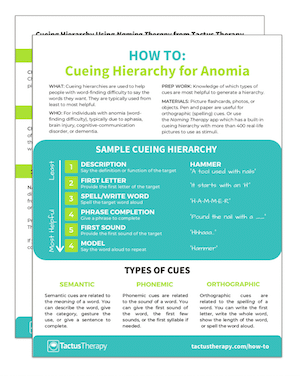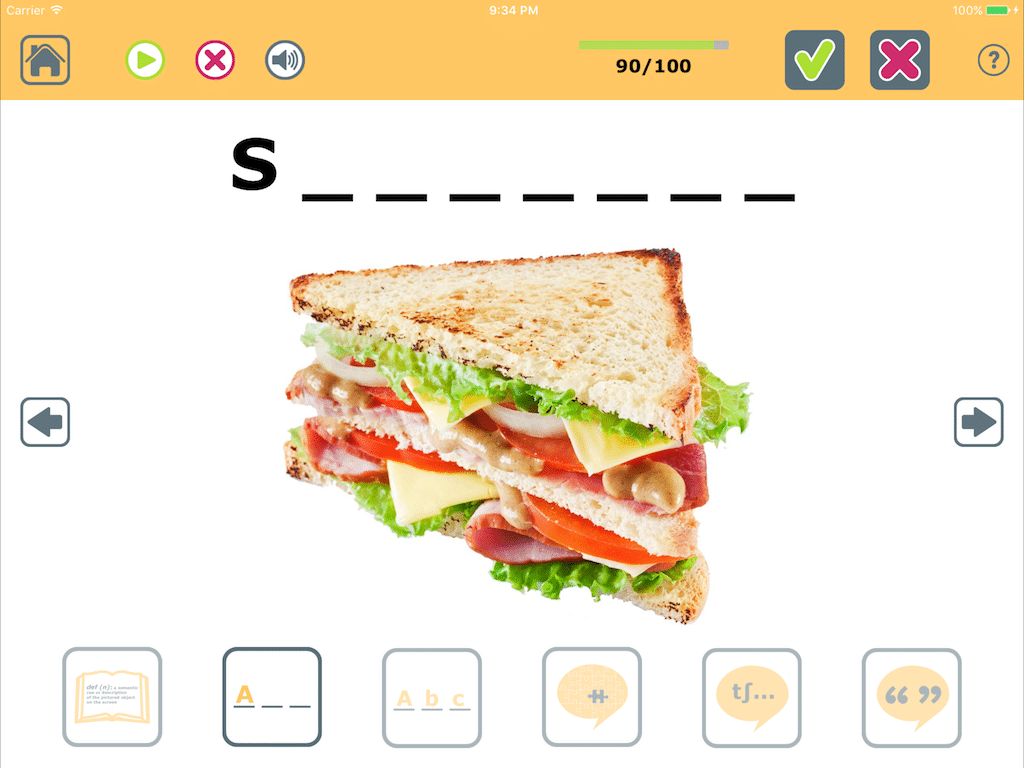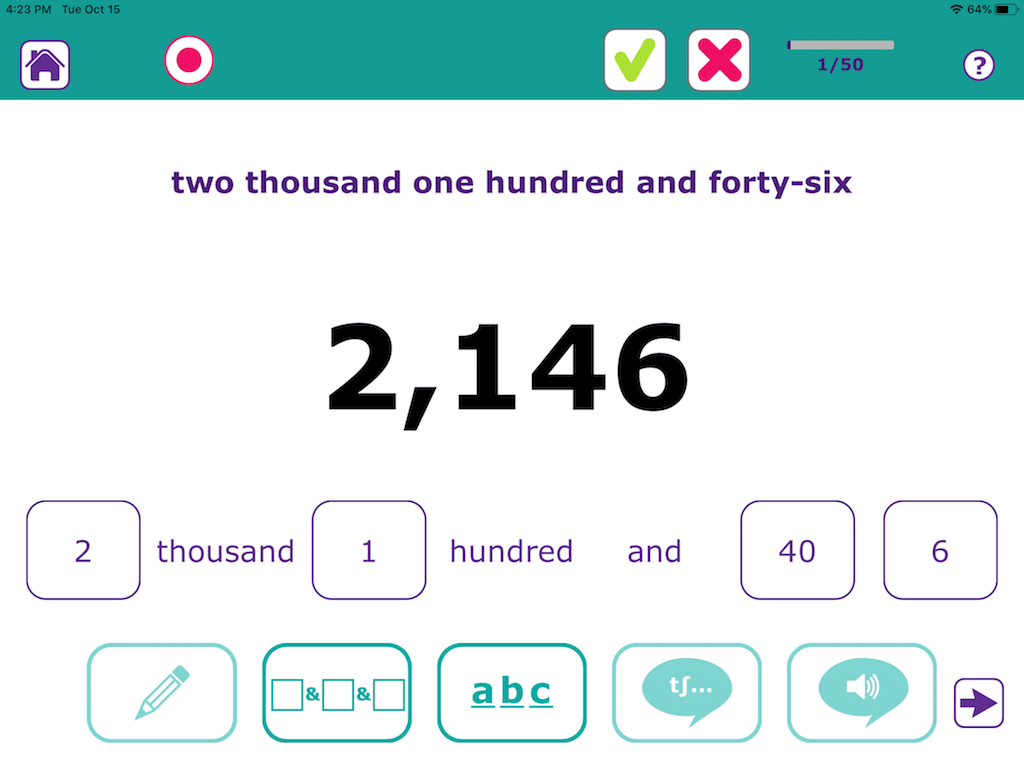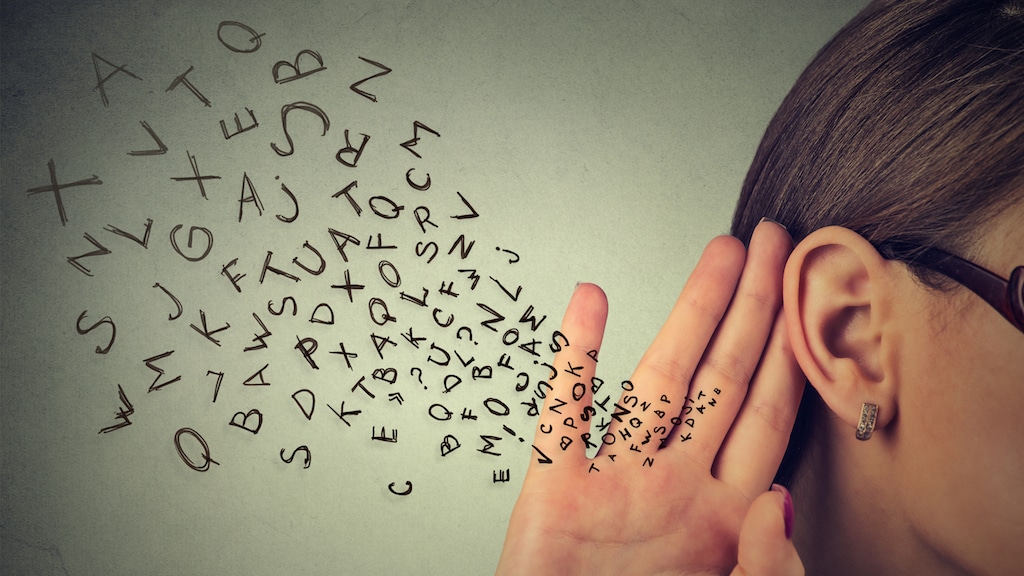How To:
Cueing Hierarchy for Word Finding in Aphasia
6 min read
You know when you’re trying to think of a word, but it just isn’t coming to you? It feels like it’s right on the tip of your tongue, but it won’t come out. Imagine how frustrating it would be to feel like this all the time. This is the reality for many people with aphasia.
There are ways to help get the word out. Speech-Language Pathologists use a variety of different hints, known as cues, in a systematic way to help people with aphasia find their words. Here’s how it works.

Types of Cues
Semantic cues are related to the meaning of a word. If the target word is phone, you could describe the function of the word (“it’s used to call people”), give the category of the word (“it’s a communication device”), or give a sentence for the person to complete (“answer the ____”). Gestures can also be a way to cue a word’s meaning – like using your thumb and little finger to simulate using a phone.
Phonemic cues are related to the sound of a word. You can give the first sound of the word (“it starts with fff…”), the first few sounds (“pho…”), or the first syllable of longer words. Phonemic cues can be extremely effective, so much so that many people with aphasia can retrieve the word when just looking at the mouth of a person making the first sound (visual phonemic cue).
Tapping out the number of syllables and providing rhyming words (“it rhymes with cone”) are less powerful sound-based cues, whereas modeling the word (“phone”) for repetition is a direct and helpful cue.
Similarly, orthographic cues give information about the spelling of the word. Writing the whole word (PHONE) or the first letter (P), or spelling the word aloud (“P-H-O-N-E”), can facilitate word finding.
Cueing Hierarchy Treatment
A cueing hierarchy puts cues in order from least helpful to most helpful, mixing the various types together. Here’s an example:
Target word: Money
In therapy, a speech-language pathologist might show a picture or an object and ask the person with aphasia to say the name. This is called a confrontation naming task. If they cannot say the word independently, the therapist then provides the cues along the cueing hierarchy, one at a time, until the person with aphasia can say the word.
The idea is to reduce the amount of help required. With repeated practice, the person with aphasia should need less powerful cues to say a word, and eventually none at all. The therapist will document which cues are most successful each session to show progress along the hierarchy.
Download this How To guide now!
Get your free PDF guide about How To: Cueing Hierarchy for Anomia

In addition to receiving your free download, you will also be added to our mailing list. You can unsubscribe at any time. Please make sure you read our Privacy Policy and Terms & Conditions.
Cueing Hierarchy Treatment using Apps
Practicing word finding with a cueing hierarchy can be challenging because it requires a partner, high-quality photos of a variety of words, and coming up with relevant cues. Technology to the rescue!
Naming Therapy Cueing Hierarchy
The evidence-based Naming Therapy app uses a cueing hierarchy approach in the Naming Practice activity. It provides semantic, phonemic, and orthographic cues, arranged in order of increasing helpfulness. Each of the 400+ high-quality pictures has 6 pre-recorded cues. Personalize the app by adding your own pictures with cues.
From left to right, the first cue is a recorded definition of the word; the second cue shows the first letter of the word and its length; third shows the full word on the screen. The next three cues play audio of a phrase to complete, the first sound or syllable, and the full word to repeat.
Number Therapy Cueing Hierarchy
The Number Therapy app offers a cueing hierarchy in the Speak activity to work on saying numbers of all sorts (money, time, dates, etc).
The cueing hierarchy along the bottom of the screen provides a prompt to write the number, a visual breakdown of how to segment the number, the printed words, the first syllable, and the correct answer. Use the recording feature to compare your production to the model – a helpful tool to encourage self-monitoring.
In both apps, the cue buttons appear faded until they are pressed, so you know which ones you’ve used. The apps produce reports with a breakdown of the cues that were helpful in eliciting the correct response.
Building Independence with Apps
Many people with aphasia feel empowered once they are put in control of their therapy by using apps. Let them choose when they get a cue and which cue they get, for the amount of help they want. They can also learn to self-cue, trying to imagine the cue before pressing the button. Similarly, allowing the person with aphasia to score their own production can improve self-monitoring, self-correction, and self-confidence.
Tips for Success with Cueing Hierarchy Treatment
- Be sure the pictures you use for confrontation naming are clear. If the person with aphasia is wondering what the picture actually is, they’re not going to be able to retrieve the word.
- Choose personally-relevant and functional words to practice, such as family members’ names.
- Whenever possible, let the person with aphasia indicate when they want the next cue. Therapists are often too quick to provide help.
- Clinicians should fully assess and understand the nature of the word-finding problem, knowing whether the deficits are in the semantic or phonemic systems, in order to select appropriate cues.
- It’s important to test the power of each cue so you can put them in the appropriate order for each individual.
- While it’s traditional to move from the least helpful to the most helpful cue, research suggests both directions can be equally effective if an errorless learning approach is desired.
- When possible, let the person with aphasia create their own cues. Personalized cues have been shown to be more effective in some studies.
Evidence for Cueing Hierarchy Treatment
In 2001, Dr. Janet Patterson reviewed 11 studies involving 20 patients to look at the efficacy of cueing hierarchies. She concluded, “Clinicians who wish to use a traditional or modified cueing hierarchy as a treatment approach for a client with a word retrieval impairment may do so, confident in the evidence that supports the technique.” However, maintenance and generalization are variable, so cueing hierarchies should not be the only treatment for word-finding difficulties and should be individualized.
As for using cueing hierarchies in a computer-based treatment, research by Ruth Fink and her team suggests “theoretically motivated, computer-assisted treatments for naming impairments can be beneficial as an adjunct to one-on-one speech/language therapy, and are an effective way to intensify and continue the rehabilitation process.”
Get a 2-page summary of this guide

In addition to receiving your free download, you will also be added to our mailing list. You can unsubscribe at any time. Please make sure you read our Privacy Policy and Terms & Conditions.
















